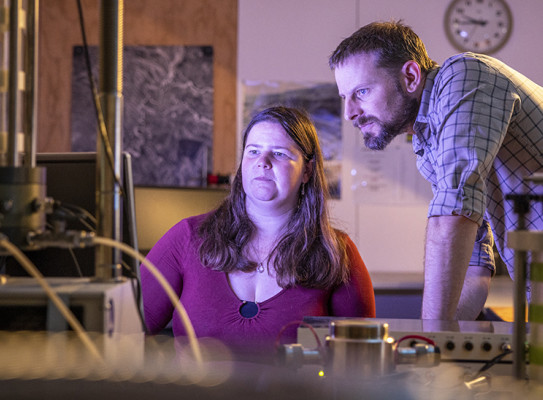Geomechanics (Rock and Soil) Laboratory

Understanding geomechanics (the study of the mechanical deformation of soil and rock) enables us to make better land-use decisions, particularly in areas prone to earthquakes, rockfall and landslides.
The data, knowledge and advice we generate helps improve New Zealand’s infrastructure, community resilience, and hazard and risk management capabilities.
Our Expertise
The Geomechanics Laboratory is a world leading research facility, which aims to study how material properties influence the stability of terrestrial and submarine slopes and faults. The laboratory leads and supports multiple research programmes, across GNS and the broader science community, under two major themes:
- Determining how shear surfaces develop and behave shallow faults and landslides to due to changes in pore water pressure and earthquakes (landslides, shallow faults and volcanic flanks).
- Understanding rock slope responses to our changing climate and it impacts on landsliding and landscape dynamics in New Zealand’s mountains and coastal environments.
The data, knowledge, and advice we generate improves Aotearoa/New Zealand’s infrastructure, community resilience, and hazard and risk management capabilities.
Our capabilities and equipment
Advanced direct shear testing:
Direct shear testing of soil materials can be undertaken in either of two dynamic back pressured shear boxes, or a high pressure back pressured shear box. These allow us to simulate the effects of static loading, groundwater pressure changes, or dynamic stress variations (e.g. due to earthquake shaking) on the behaviour of soil and rock materials commonly found in landslides.
Triaxial and uniaxial compression testing:
Uniaxial or triaxial testing of fractured or intact rock can be undertaken in either of two compression loading frames. These can be configured to determine environmental factors affecting the stiffness, strength, or progressive failure of intact, or fractured rock at equivalent depths of up to 500 m below the surface. Contact Kerry Leith
Physical properties:
Facilities also allow the derivation of standard material indices and physical properties of soil and rock samples. These include density and moisture contents, liquid and plastic limits, air permeability, and particle size testing. Contact Barbara Lyndsell
Our research also contributes to nationally significant data sets, which include the geomechanical properties of landslides, laboratory testing data and national and international case studies.
Our equipment:
- Dynamic Back Pressured Shearboxes
- High Pressure Back Pressure Shearbox
- 400kN Virtual Infinite Stiffness Load Frame
- 50kN Load Frame
- Laser Diffraction Particle Size Analyser
- Olympus Pulse Generator and Pico Oscilloscope (for Seismic wave analysis)
Our Clients
Our team collaborates with a range of clients, including central and local government, and infrastructure and service providers.
Location
The Geomechanics Laboratory is located at the GNS Science campus in Avalon, Wellington.
Our Team
Our team of five is led by a Lead Scientist Geomechanics, with Sonja Bermudez as Labs and Collections Manager
